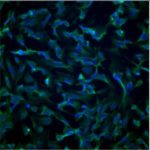Lien vers Pubmed [PMID] – 33969035
Lien DOI – 63784110.3389/fvets.2021.637841
Front Vet Sci 2021 ; 8(): 637841
Unlike other MAC members, Mycobacterium avium subsp. paratuberculosis (MAP) does not produce glycopeptidolipids (GPL) on the surface of the cell wall but a lipopentapeptide called L5P (also termed Lipopeptide-I or Para-LP-01) characterized in C-type (bovine) strains. This lipopeptide antigen contains a pentapeptide core, D-Phenylalanine-N-methyl-L-Valine-L-Isoleucine-L-Phenylalanine-L-Alanine, in which the N-terminal D-Phenylalanine is amido-linked with a fatty acid (C18-C20). The molecular and genetic characterization of this antigen demonstrated that L5P is unique to MAP. Knowledge of the structure of L5P enabled synthetic production of this lipopeptide in large quantities for immunological evaluation. Various studies described the immune response directed against L5P and confirmed its capability for detection of MAP infection. However, the hydrophobic nature of lipopeptide antigens make their handling and use in organic solvents unsuitable for industrial processes. The objectives of this study were to produce, by chemical synthesis, a water-soluble variant of L5P and to evaluate these compounds for the serological diagnosis of MAP using well-defined serum banks. The native L5P antigen and its hydrosoluble analog were synthesized on solid phase. The pure compounds were evaluated on collections of extensively characterized sera from infected and non-infected cattle. ROC analysis showed that L5P and also its water-soluble derivative are suitable for the development of a serological test for Johne’s disease at a population level. However, these compounds used alone in ELISA have lower sensitivity (Se 82% for L5P and Se 62% for the water-soluble variant of L5P) compared to the Se 98% of a commercial test. Advantageously, these pure synthetic MAP specific antigens can be easily produced in non-limiting quantities at low cost and in standardized batches for robust studies. The fact that L5P has not been validated in the context of ovine paratuberculosis highlights the need to better characterize the antigens expressed from the different genetic lineages of MAP to discover new diagnostic antigens. In the context of infections due to other mycobacteria such as M. bovis or the more closely related species M. avium subsp. hominissuis, the L5P did not cross react and therefore may be a valuable antigen to solve ambiguous results in other tests.





